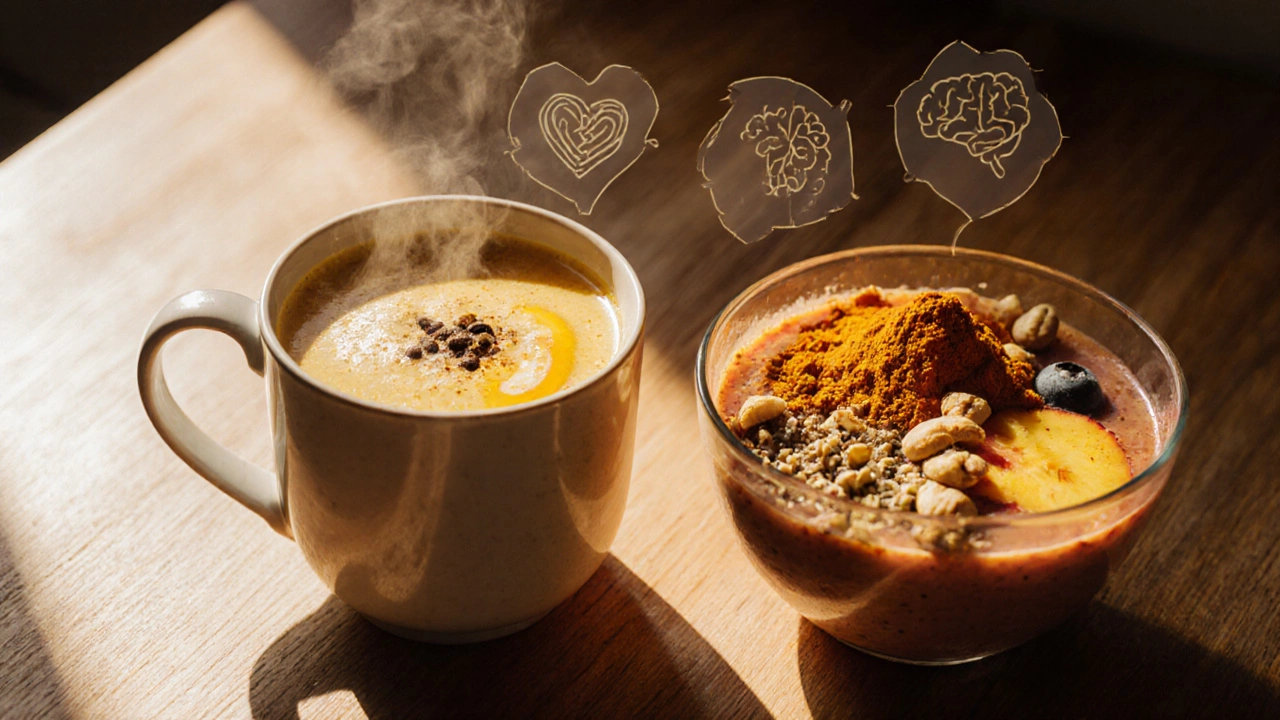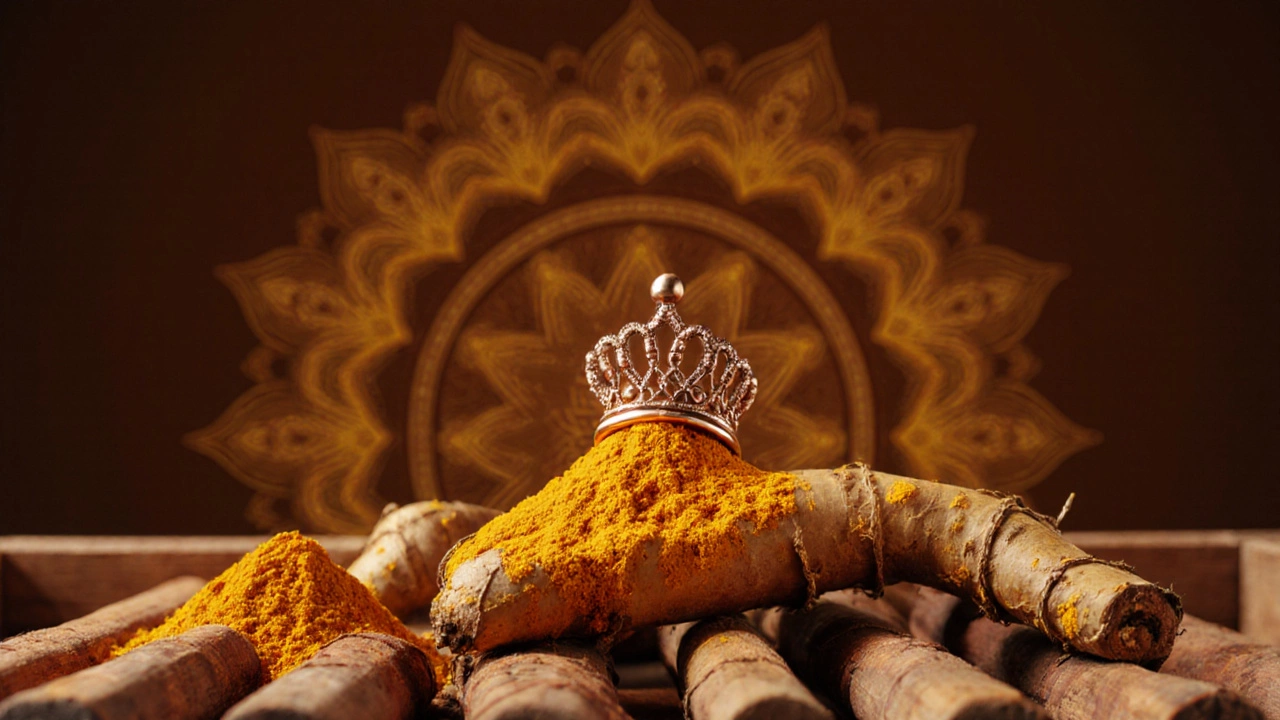When people ask, “What is the king of healing herbs?” most Ayurvedic practitioners point to turmeric. This golden root has been a staple in Indian kitchens and medicine cabinets for millennia, prized for its bright color, warm flavor, and powerful health‑boosting compounds.
Key Takeaways
- Turmeric (Curcuma longa) is the most widely studied healing herb in modern science.
- Its active compound, curcumin, delivers strong anti‑inflammatory and antioxidant effects.
- Regular consumption supports joints, heart, brain, skin, and metabolic health.
- Best absorbed when paired with black pepper and healthy fats.
- Generally safe, but high doses may interact with blood‑thinners or gallbladder issues.
What Makes Turmeric the King of Healing Herbs?
Turmeric is a rhizomatous herb in the ginger family (Zingiberaceae). Its bright orange‑yellow pigment comes from curcumin, a polyphenol with strong antioxidant activity. In Ayurveda, turmeric is classified as a “Rasayana” - a rejuvenating agent that balances all three doshas (Vata, Pitta, Kapha) and promotes longevity.
Unlike many herbs that target a single symptom, turmeric influences multiple cellular pathways. It modulates NF‑κB, COX‑2, and cytokine production, which are central to inflammation and oxidative stress. This broad‑spectrum action is why it earned the royal title.
Science Behind Curcumin
Curcumin (C₂₁H₂₀O₆) is the principal bioactive component of turmeric. Over 10,000 scientific papers have examined its mechanisms. Key findings include:
- Scavenging free radicals - reduces oxidative DNA damage.
- Inhibiting inflammatory enzymes - lowers joint pain and swelling.
- Regulating gene expression - supports detoxification and cellular repair.
Clinical trials show that standardized curcumin extracts (95% curcuminoids) can cut C‑reactive protein by up to 40% in chronic inflammation patients. The evidence base is strongest for joint health, metabolic syndrome, and certain cancers.

Top Health Benefits Backed by Research
Below are the most compelling benefits, each linked to specific studies or Ayurvedic texts.
- Joint & Musculoskeletal Health: Curcumin inhibits COX‑2, easing osteoarthritis pain. A 2023 randomized trial reported a 30% reduction in WOMAC scores after 12 weeks of 500mg curcumin twice daily.
- Heart Protection: Turmeric improves endothelial function and lowers LDL oxidation. A meta‑analysis (2022) found a 12% drop in systolic blood pressure in participants taking curcumin supplements.
- Brain Support: Curcumin crosses the blood‑brain barrier, enhancing BDNF levels. Early‑stage Alzheimer’s patients showed slower cognitive decline after 18 months of 400mg curcumin daily.
- Metabolic Balance: It boosts insulin sensitivity and reduces triglycerides. In type‑2 diabetes cohorts, fasting glucose fell by an average of 15 mg/dL.
- Skin Health: Anti‑inflammatory and antimicrobial properties help with acne, psoriasis, and age‑related wrinkles. Topical turmeric masks have been used in Ayurvedic skin regimens for centuries.
How to Use Turmeric Daily for Maximum Benefit
Getting curcumin into the bloodstream efficiently is the biggest challenge. Here’s a practical routine anyone can follow.
- Golden Milk: Warm 250ml of milk (dairy or plant‑based), add ½tsp turmeric powder, a pinch of black pepper (piperine boosts absorption 2000%), and a teaspoon of ghee or coconut oil. Drink in the evening.
- Smoothie Boost: Blend 1tsp turmeric with banana, spinach, and almond butter. The healthy fats aid curcumin uptake.
- Cooking Spice: Include turmeric in curries, soups, and stir‑fries. Pair with ginger and garlic for synergistic anti‑inflammatory effects.
- Supplement Form: Use a standardized curcumin extract with piperine. Typical dosage: 500mg twice daily, taken with meals.
Consistency matters more than occasional high doses. Aim for daily intake of 500‑1000mg curcumin equivalents to see measurable results.
Safety, Contraindications, and Common Pitfalls
Turmeric is safe for most people, but be aware of the following:
- Blood‑thinners: Curcumin can enhance anticoagulant effects. If you’re on warfarin or aspirin, keep intake under 1tsp of powder per day and consult your doctor.
- Gallbladder disease: High doses may aggravate gallstones. Those with biliary issues should limit consumption.
- Pregnancy: Culinary amounts are fine, but large supplement doses are not recommended without medical guidance.
- Stomach upset: Some individuals experience mild heartburn. Pair turmeric with fats and pepper to reduce irritation.
Always start with a small amount and gradually increase to assess tolerance.

Turmeric vs. Other Popular Healing Herbs
| Herb | Primary Active Compound | Core Benefit | Typical Daily Dose | Key Contraindication |
|---|---|---|---|---|
| Turmeric | Curcumin | Anti‑inflammatory & antioxidant | 500mg curcumin extract (≈1tsp powder) + black pepper | Blood‑thinners, gallbladder disease |
| Ashwagandha | Withanolides | Adaptogenic stress relief | 300‑500mg root extract | Thyroid medication, pregnancy |
| Tulsi (Holy Basil) | Eugenol | Immune modulation | 1‑2tsp dried leaves or tea | Low blood sugar medications |
| Ginger | Gingerol | Digestive aid & nausea relief | 1‑2g fresh root or 250mg extract | Bleeding disorders at high doses |
While all four herbs offer valuable health support, turmeric’s unique blend of anti‑inflammatory, antioxidant, and metabolic actions gives it the “king” status. Use it alongside other herbs for a balanced, synergistic regimen.
Quick Reference Checklist
- Choose high‑quality, organic turmeric powder or a 95% curcumin extract.
- Add black pepper (½tsp per 1tsp turmeric) for absorption.
- Pair with healthy fats (ghee, coconut oil, olive oil).
- Start with ½tsp powder daily; increase to 1tsp if tolerated.
- Monitor for any signs of bleeding or gallbladder discomfort.
- Combine with other herbs (ashwagandha for stress, tulsi for immunity) for holistic care.
Frequently Asked Questions
Is turmeric the same as curry powder?
No. Curry powder is a blend of many spices (including turmeric) and often contains fenugreek, coriander, and cumin. Turmeric is the single bright‑yellow root that gives curry its color.
Can I replace my arthritis medication with turmeric?
Turmeric can complement arthritis treatment by reducing inflammation, but it should not replace prescribed drugs without a doctor’s approval.
How long does it take to see benefits?
Most people notice reduced joint soreness within 2‑4 weeks of consistent daily intake. Metabolic improvements (like better blood sugar) may take 8‑12 weeks.
Is it safe for children?
Culinary amounts in food are safe for kids. For supplements, keep doses under 250mg curcumin per day and consult a pediatrician.
What’s the best way to store turmeric powder?
Store in an airtight container away from light and heat. A dark pantry or a glass jar with a seal works well and preserves potency for up to two years.
Whether you’re looking to ease joint pain, boost heart health, or simply add a vibrant flavor to your meals, turmeric truly lives up to its royal reputation. By using it smartly-paired with pepper, fat, and the right dose-you can tap into centuries of Ayurvedic wisdom and modern scientific backing.





